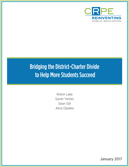Read the Executive Summary.
Animosity between school districts and charter schools has been the norm since the nation’s first charter school opened in 1992, but that is now starting to change. In at least 35 urban school districts with significant numbers of charter schools, efforts are under way to jointly improve instruction, align policies, address inequities, or garner efficiencies. About a dozen of these districts are using cooperation, also commonly referred to as district-charter collaboration, to drive decisions and address systemic challenges, including tracking school performance, student enrollment, and school closure. Cooperation in some cities has yielded real, tangible improvements for students and families, for example around more transparent discipline data and streamlined enrollment systems, while in other cities progress has stalled or even gone backwards.
Based on six years of research, our work has surfaced some fundamentals about the promises and challenges of cross-sector cooperation to date.
Key Findings:
- In cities with sizeable charter school student populations, cross-sector policy coordination is a necessity, not a nicety.
- Despite the urgent need, cooperation is too often treated as a time-limited, forced marriage rather than a sustained effort and long-term relationship.
- Some cooperation efforts are simply not worth the effort.
- The cities logging serious progress are addressing chronic challenges and common goals for improving quality and equity, rather than getting mired in a litany of short-term tasks.
- Top officials must commit to cooperation and ensure that their entire organization follows suit.
The report includes recommendations for district and charter leaders, State Education Agencies, and funders to better support the often difficult, politically divisive work of cooperation.






